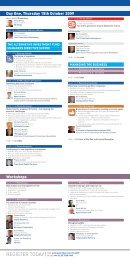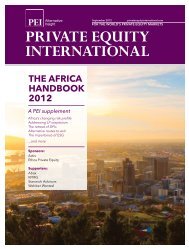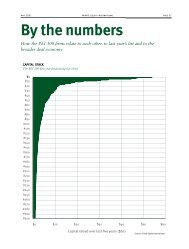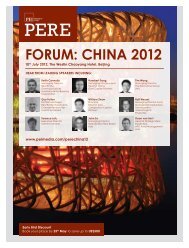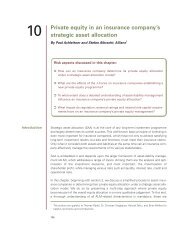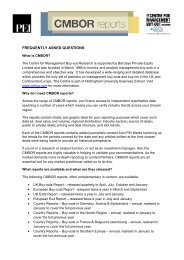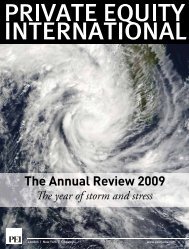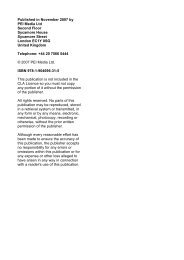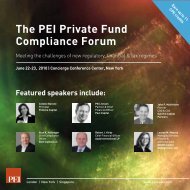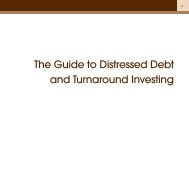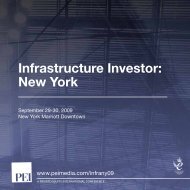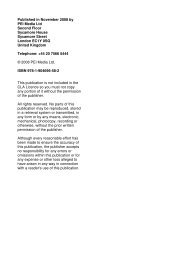THE ANNUAL REVIEW 2010 - PEI Media
THE ANNUAL REVIEW 2010 - PEI Media
THE ANNUAL REVIEW 2010 - PEI Media
Create successful ePaper yourself
Turn your PDF publications into a flip-book with our unique Google optimized e-Paper software.
private equity annual review <strong>2010</strong> pa g e 109<br />
MAY<br />
The Mongolian opportunity<br />
“Although interest in Mongolia, which is rich in largely untapped<br />
resources including coal, gold, copper and iron ore, is coming<br />
from investors and mining companies around the world, the success<br />
of their investments there may depend to a large extent on<br />
the appetite of one Asian country: its resource-hungry neighbour<br />
China. Since the two countries signed a ‘Treaty on Friendship<br />
and Cooperation’ in 1994, China has become Mongolia’s largest<br />
trading partner and biggest importer of natural resources.<br />
China is, of course, a significant trading partner to other natural<br />
resource-rich regions and countries, such as Australia, Brazil<br />
and South Africa. However, the advantage Mongolia has lies in<br />
sharing a land border with China.”<br />
JUNE<br />
The rise of the Asian secondary buyout<br />
“Secondary buyouts are an attractive exit route, especially in a<br />
market like Australia where recent private equity-backed IPOs have<br />
performed poorly. However, while secondary buyouts offer GPs<br />
a relatively straightforward way to both deploy capital and return<br />
cash, such deals can make LPs wary. ‘For the LP, there’s always the<br />
concern that when a GP raises a large fund, it’s under pressure to<br />
invest money and will pay a high price,’ said one Singapore-based<br />
LP. ‘In general, it’s not usually been a good experience when one<br />
buyout fund is buying from another. The sellers – being private<br />
equity investors – always try to extract the best price, so it’s not<br />
easy to buy from them.’”<br />
JULY/AUGUST<br />
On the departure of TPG’s China boss<br />
“Weijian Shan is the latest in the long line of big-name Chinese<br />
finance professionals to strike out alone and launch private<br />
equity funds. Notable precedents include former Goldman<br />
Sachs China head Fang Fenglei, who launched his own firm<br />
Hopu Investment Management in 2007; and, most recently,<br />
Fred Hu, former Greater China chairman at Goldman Sachs,<br />
who retired this April amid a flurry of media reports that he<br />
was also setting up his own fund. Shan’s departure served to<br />
highlight once again the tendency of private equity firms in<br />
China, whether domestic or foreign, to build their businesses<br />
on the shoulders of one very prominent local business or finance<br />
professional. Though private equity firms worldwide hang their<br />
reputation on their key men, the Chinese key man (singular)<br />
phenomenon has been exaggerated to the extreme in a country<br />
where it’s almost impossible to do business without the right<br />
name to get you through the door.”<br />
SEPTEMBER<br />
Australian fundraising woes<br />
“Clearly, Australia is still a good place to invest money – the economy<br />
is growing and, while it may only be 2 percent of the world’s GDP,<br />
it is considerably more than 2 percent of the world’s investable<br />
universe. However, in the post-downturn environment it will be<br />
a case of survival of the fittest – and, based on portfolio performances<br />
coming out of the recent downturn, most insiders are<br />
pretty clear on which firms make the cut. ‘If there were a dozen<br />
managers, then there are six who have jostled themselves into a<br />
go-forward position. Then there are the six who are not credible<br />
competitors to good firms anymore,’ commented a fund of funds<br />
manager. As Darwinism slowly sets in, and LPs vote with their<br />
feet, the landscape of Australia’s domestic private equity market<br />
will evolve dramatically.”<br />
OCTOBER<br />
Chinese insurers get the green light for private equity<br />
“Though unsurprisingly the measure comes with a fair amount of<br />
small print, the news is nothing but good for China’s GPs and<br />
LPs alike. For domestic fund managers, the most obvious plus is<br />
the creation of yet another rich vein of capital to potentially tap<br />
into on the fundraising trail. According to China-focused private<br />
equity research body Zero2IPO, the new rules mean as much as<br />
RMB226 billion (€26.2 billion; $33.2 billion) would be allowed to<br />
enter China’s private equity market, given total Chinese insurance<br />
industry assets stood at RMB4.52 trillion at the end of June this year.<br />
But perhaps more significant than the capital itself, is the change<br />
the CIRC measure could bring about in the make-up of China’s<br />
domestic LP base, which until now has largely consisted of high<br />
net worth individuals (HNWIs) and government-related bodies.”<br />
NOVEMBER<br />
India struggles to define its market<br />
“China, as the indisputable king of the BRIC markets, is big and<br />
self-sufficient enough in terms of funding to afford the luxury<br />
of being able to ignore its emerging market peers. However,<br />
many Indian GPs (and there are many – up to 400 according<br />
to most estimates), rely on a largely foreign LP base, and<br />
therefore feel a keen sense of competition with China – and<br />
increasingly Brazil – in what is still a constrained fundraising<br />
environment. Perhaps because of this need to compete, much<br />
of the content of the Private Equity International India Forum<br />
in Mumbai sought to define the specific characteristics of the<br />
Indian market and bring uniquely Indian interpretations to<br />
familiar private equity terms.”<br />
DECEMBER/ JANUARY<br />
The relative merits of MENA<br />
“In MENA, meanwhile, oversupply of capital is hardly the problem.<br />
There are many reasons why so many investors shun it. According<br />
to a <strong>PEI</strong> white paper, most LPs see managers with questionable<br />
track records, a blinding lack of transparency, poor governance<br />
practices and scary politics. Ignorance also plays a part, if you<br />
believe those who know the region well. Take Saudi Arabia, for<br />
example. With a young and growing population of 27 million,<br />
the country has a large, diversified economy and a government<br />
that has worked hard to attract foreign investment.” n



